Hat tip to Gideon Rachman, chief foreign-affairs columnist of the Financial Times, for providing a plausible answer to the question (Has China won?) I wrote about in the previous post. Easy to understand, argues Rachman, why China might be feeling its oats. It is opening up its economy after having [continue reading . . . ]
Will we live in a unipolar world dominated by China in 20 or 30 years? Not likely, says Columbia University professor Jeffrey Sachs. Writing in the Financial Times, Sachs notes that China’s economy, already larger than that of the U.S. measured at international prices (what is called purchasing-power parity), will [continue reading . . . ]
Don’t miss the excellent piece on the importance of immigrants to Silicon Valley in the New York Times February 9, 2017. Some highlights: “Silicon Valley is unlikely, as a phenomenon — it is not the default state of the world,” said John Collison, an immigrant from Ireland who is a [continue reading . . . ]

When it comes to median household income, tech powerhouses, especially in California, and suburbs of Washington, D.C., tend to dominate the top lists. Among cities with more than 65,000 population, Palo Alto ranked No. 1 in 2015 (latest data) at almost $148,000. Half of households in Palo Alto had higher income [continue reading . . . ]
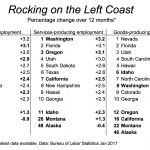
It’s winter outside — cold, snowy, wet. But when it comes to the economy, especially as measured by employment growth, there’s a heat wave on the West Coast (aka the Left Coast). Washington and Oregon, in particular, are mucho caliente. Employment in the services-providing sectors grew faster in the Evergreen [continue reading . . . ]
I can think of no more fascinating global political subject these days than China. So many things make it extraordinary. For starters, China’s one-child policy means that China will grow old before it grows rich. Cheap labor made China the world’s “manu-factory”. But the shrinkage of China’s working-age population has [continue reading . . . ]
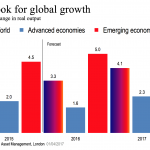
The global economy is likely to grow at between 3% and 4% in 2017 adjusted for inflation and differences in exchange rates. Emerging economies, led by Asia, are likely again to outgrow advanced economies (the U.S., Europe, Japan). That’s the word from one of the world’s most respected and widely followed [continue reading . . . ]
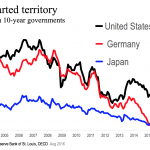
For a quick economic update for members of Bellevue Rotary recently, I updated several slides I usually include as a part of my talks and added a new one or two. You can download all of them as a PDF file here. Among bullet points: We live in a slow-growth world. [continue reading . . . ]
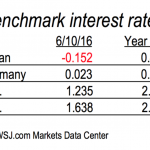
How low can interest rates go? I don’t know. Rates hit new all-time lows in parts of the world last week. The table nearby lists yields last week and a year ago on the 10-year government bonds of four of the most important issuers. At 10 years, only Japan is [continue reading . . . ]
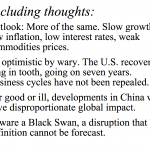
I am a fan of the book China in Ten Words by the Chinese novelist Yu Hua (translated by Allan H. Barr). A delightful little book. I have not yet been to mainland China. When I go, I will tuck this valuable little book into my carry-on. It can easily [continue reading . . . ]
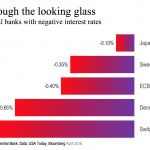
What if the negative interest rate policies (NIRP) that have been adopted by major central banks had effects opposite what was intended? The idea is to fight DEflation and to nudge consumers to spend by penalizing banks for keeping money on deposit. The theory is that banks will lend rather [continue reading . . . ]
The progressive in me cheers the idea that the minimum wage ought to go up. The federal minimum wage, $7.25 an hour, set by the Fair Labor Standards Act, hasn’t been raised since 2009. Good luck feeding more than one or two mouths or making rent in a city working [continue reading . . . ]